Coat Color Genetics
You can also see the different colors as they grow on this page.
To date, there are at least ten known loci that control coat color in gerbils; each locus controls a different trait. Each of these loci has a dominant allele, that usually represents the form of the trait commonly found in the wild, and at least one recessive allele, representing a less common form of the trait. The eight loci discussed on this page are: A, C, D, E, P, Uw, Sp, and Re. I will also touch on Steel-factor, which is a different sort of locus. The loci not discussed include the Semi-Dominant Lethal Spotting and Wavy mutations, which are not known to be present in the USA at this point.
To understand how these loci work, it is necessary to know how color is structured on the hair.

B: The middle band is a golden brown. Because of the way the individual hairs of the coat overlap, this middle band is the most visible, and contributes most to the perceived overall color.
C: The tip of the hair is black, which gives rise to "ticking", the stippled appearance of colors such as Agouti and Nutmeg.
This gray-brown-black pattern causes the wild-colored coat to appear a dark brown.
Navigation
| A-locus | C-locus | D-locus | E-locus | P-locus | Uw-locus | Sp-locus | Re-locus | Steel-factor |
The C-locus: Full Color vs. Albinism
The C-locus controls the different levels of albinism. Many species have a dominant, full-color allele C, a fully recessive, "true" albino allele c (which causes a complete lack of pigment), and a series of intermediate alleles between them. The albino series, from C to c, forms a dominance hierarchy. The more impact an allele has on pigment production, the less dominant it tends to be.
Gerbils have the full-dominant C, and two intermediate alleles: cchm and ch. If the complete albino mutation, c, has occurred in gerbils, it has since been lost. As in other species, the C allele represents full intensity of color. The other two alleles cause what is known as acromelanistic albinism. In this form of albinism, production of pigment is affected by temperature. Pigment production is inhibited at the higher temperatures found at the core of the body, near the major organs. So color forms mostly on the extremities: feet, tail, ears, nose. This is the type of albinism exhibited by Siamese cats.
In gerbils, the cchm allele, formerly known as cb, leads to the familiar "Siamese" pattern: a lightened main body with dark extremities. The "points" (ears, nose, paws, and tail) are only slightly lightened from the original color, while the body is a more washed out version of the original color. The eye pigmentation is diluted as well: the eyes appear black, but show a deep garnet color under bright light. This pattern in general is called Colorpoint (abbreviated CP).
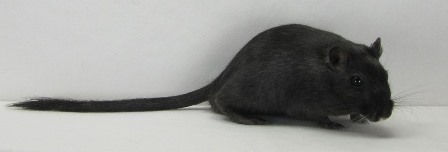
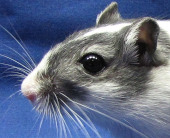
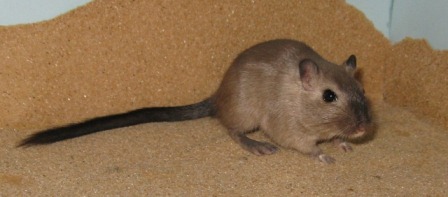
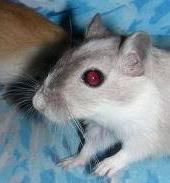
The recessive C-alleles have more of an effect on red/yellow pigment (phaeomelanin) than on black pigment (eumelanin). So while the coat of a Colorpoint Black gerbil is only diluted to a dark brown, the coat of an Agouti turns a silvery color in the Colorpoint form due to the reduction of the red pigment.
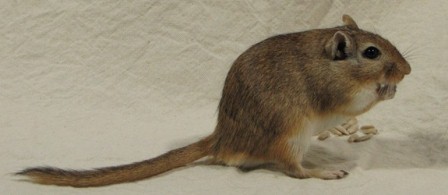

A- C- D- E- P- Uw- :: (White-Bellied Golden) Agouti
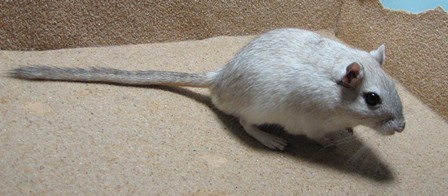

A- cchmcchm D- E- P- Uw- :: CP Agouti
The ch allele is a more extreme version of cchm; in gerbils, pigment is generally restricted to the tail alone. The rest of the coat is a clear white, and the eyes are lightened to pink. This pattern can be likened to the Himalayan coat in mice, rabbits, etc. The ch allele masks the effects of most other loci, so any gerbil with two ch alleles will have a white body and pink eyes.
This will usually make a Dark-Tailed White (DTW) gerbil, with pigmented fur appearing on the tail as the gerbil ages. The depth of pigment on the tail varies; typically, a nonagouti-based (aa) DTW will have a darker tail than an agouti-based (A-) DTW.
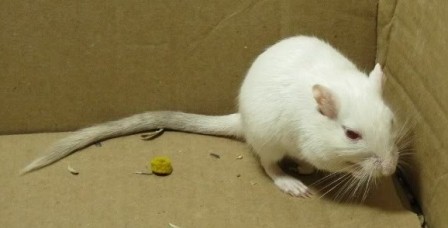
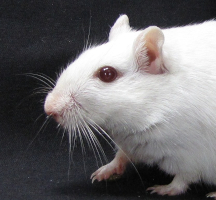
-- chch -- -- -- -- P-
Dark-Tailed White
However, if a DTW gerbil also has two alleles for the "pink-eyed dilution" trait, the tail will usually remain white, making a Pink-Eyed White (PEW) gerbil. A PEW coat will be produced by the pink-eyed dilution trait interacting with any combination of recessives at the C-locus. So a PEW gerbil could be chchpp, cchmchpp, or cchmcchmpp. Because PEW is created by the interaction between two different genes, it is not considered a "true albino".

-- c-c- -- -- -- pp -- :: Pink-Eyed White
The cchm allele is incompletely dominant over ch, so a gerbil with one cchm allele and one ch allele has a coat similar to that produced by two cchm alleles, but lightened, due to the influence of the ch allele. This pattern is known as Light Colorpoint (LCP).

aa cchmcchm D- E- P- Uw- :: CP Black (Burmese)
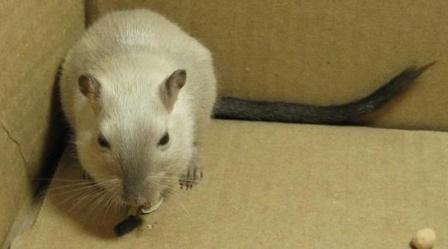
aa cchmch D- E- P- Uw- :: LCP Black (Siamese)
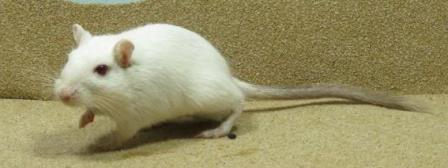
aa chch D- E- P- Uw- :: Dark-Tailed White
top

Unless otherwise specified, all text and images at this site are licensed under a
Creative Commons Attribution-Noncommercial-Share Alike 3.0 United States License